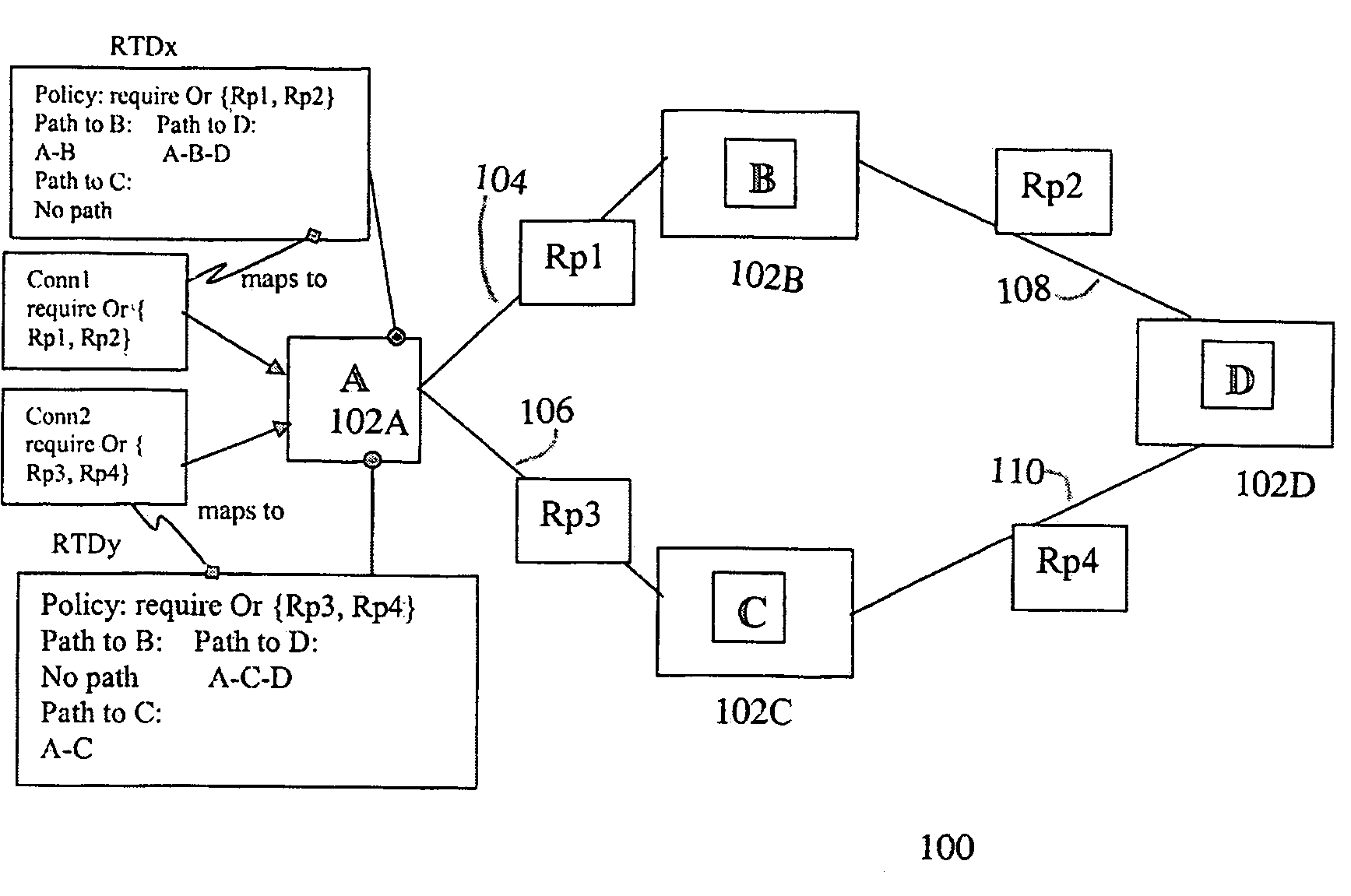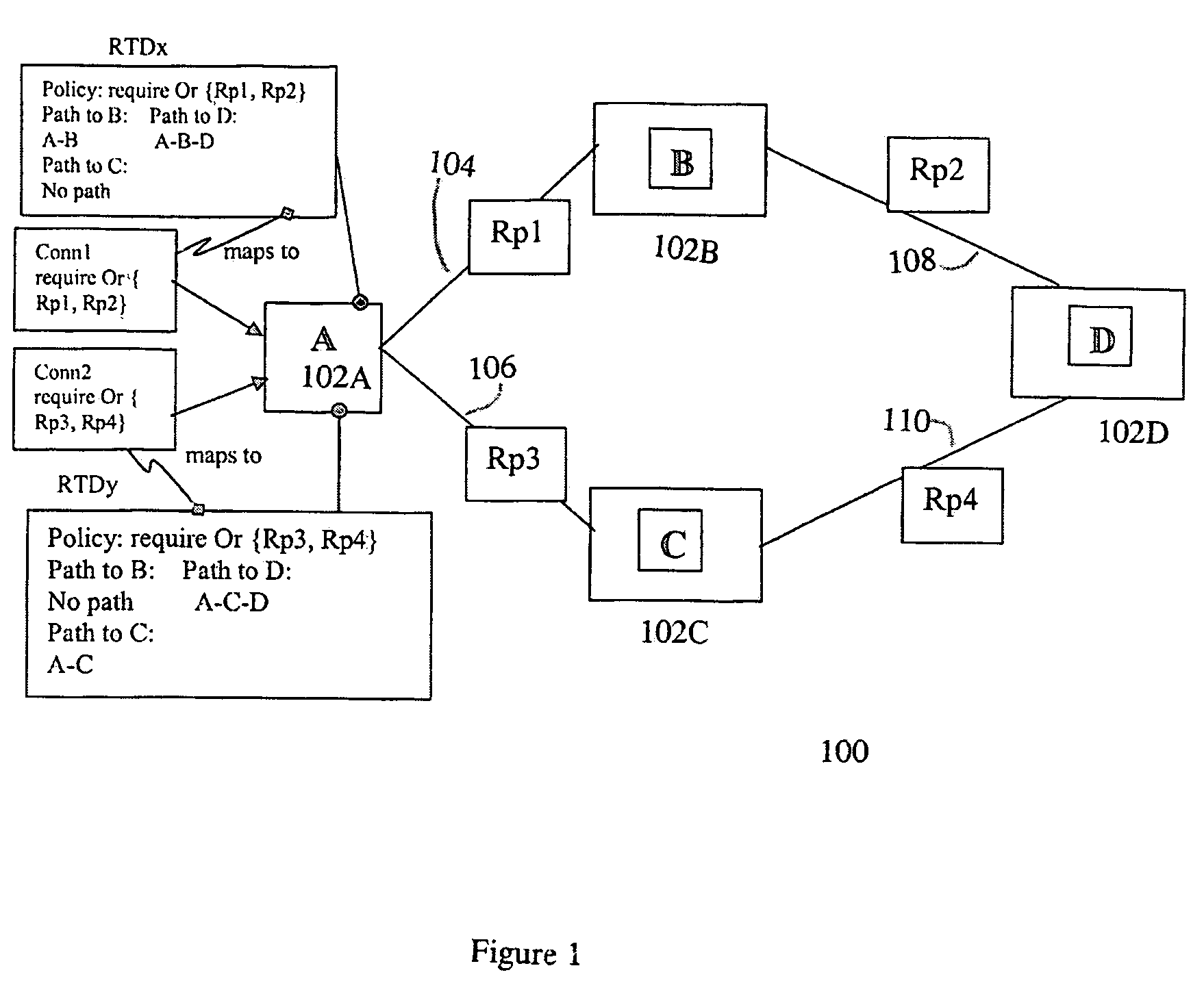System and method for identifying pre-computed paths in a policy-based routing network
a technology of pre-computed paths and routing networks, applied in the field of communication networks, can solve problems such as not knowing how to provide a system and method for identifying suitable pre-computed paths
- Summary
- Abstract
- Description
- Claims
- Application Information
AI Technical Summary
Benefits of technology
Problems solved by technology
Method used
Image
Examples
example 1
[0054]Consider a connection request that has a policy defined as:
[require (logical_or (Rp-NSC—1, Rp-NSC—2})]
The policy translates into:
RPE1: (Rp-NSC—1) or
RPE2: (Rp-NSC—2)
[0055]Table 3 provides a mapping of the connection request policy against several RTDs, numbered 2 to 5.
[0056]
TABLE 3Matching a Connection request's Policy against a number of RTDs of anodeRTD PolicyMap?RemarksRTD 2YesConnection request RPE1 matches[require (logical_orRTD RPE1. This indicates that the{Rp-NSC_1, Rp-NSC_3});path represented by that RTD maymust-avoid (singlecontain links that are tagged with{Ne-NSC-1})]Rp-NSC_1 which is required bywhich translates into:the connection request.(Rp-NSC_1) or(Rp-NSC_3)(Ne-NSC_1)RTD 3NoNone of the RTD and connection[require (logical orrequest RPEs match.{Ne-NSC_3, Ne-NSC_4});must-avoid (single{Ne-NSC-1})]which translates into:(Ne-NSC_3) or(Ne-NSC_4):(Ne-NSC_1)RTD 4NoNone of the RTD and connection[must-avoid (singlerequest RPEs match. RTD actually{Ne-NSC-1})]whichhas no RPEs...
example 2
[0057]If a connection request that has a policy defined as:
[must-avoid (logical_or {Ne-NSC—1, Ne-NSC—2})][0058]which translates into:
APE1: (Ne-NSC—1) or
APE2: (Ne-NSC—2)
[0059]Table 4 provides a mapping of the connection request policy against several RTDs, numbered 2 to 4.
[0060]
TABLE 4Matching a Connection request's Policy against a number of RTDs of anodeRTD PolicyMap?RemarksRTD 2NoRTD and connection request RPEs do[require (logical_ornot match. Connection request has no(Ne-NSC_3,RPEs; while RTD has 2 RPEs.Ne-NSC_4});must-avoid (single{Ne-NSC-1})]which translates into:(Ne-NSC_3) or(Ne-NSC_4)(Ne-NSC_1)RTD 3YesRTD and connection request RPEs[must-avoid (singlematch. Both have no RPEs. Although{Ne-NSC-5})]the connection request maps to thiswhich translates into:RTD, it might not be the best RTD to(Ne-NSC_5)use since it does not fulfill theconnection request's APErequirements.RTD 4NoConnection request APE2 matches[require (logical_orRTD RPE1. This indicates that the{Ne-NSC_2,path repres...
example 3
[0083]Consider a connection request with a policy defined as:
[require (logical_or {Ne-NSC—1}; logical_or {Rp-NSC—3, Rp-NSC—4}); must-avoid (logical_or {Ne-NSC 10, Ne-NSC—11})]
translates into:
RPE1: (Ne-NSC—1 & Rp-NSC—3) or
RPE2: (Ne-NSC—1 & Rp-NSC—4)
APE1: (Ne-NSC—10)
APE2: (Ne-NSC—11)
[0084]Table 6 shows all the RTDs to which the connection request maps and which RTD is selected.
[0085]
TABLE 6Matching a Policy for a Connection request against existing policies forRTDsRTD PolicyRTD Selected?RemarksRTD 2NoRPE2, RPE3 in RTD[require (single {Ne-NSC_1}; logical_ormatches RPE1 and RPE2 in{Rp-NSC_1, Rp-NSC_3, Rp-NSC_4})]the connection request.which translates into:Not selected.RPE1: (Ne-NSC_1 & Rp-NSC_1)RPE2: (Ne-NSC_1 & Rp-NSC_3)RPE3: (Ne-NSC_1 & Rp-NSC_4)RTD 3YesRPE1 in RTD matches[require (single {Ne-NSC_1};single {Rp-RPE1 and RPE2 in theNSC_3});connection request. Also,must-avoid (logical_or {Ne-NSC_10, Ne-APE1 and APE2 matchNSC_12})]APE1 and APE2 of thewhich translates into:connection requ...
PUM
 Login to View More
Login to View More Abstract
Description
Claims
Application Information
 Login to View More
Login to View More - R&D
- Intellectual Property
- Life Sciences
- Materials
- Tech Scout
- Unparalleled Data Quality
- Higher Quality Content
- 60% Fewer Hallucinations
Browse by: Latest US Patents, China's latest patents, Technical Efficacy Thesaurus, Application Domain, Technology Topic, Popular Technical Reports.
© 2025 PatSnap. All rights reserved.Legal|Privacy policy|Modern Slavery Act Transparency Statement|Sitemap|About US| Contact US: help@patsnap.com



